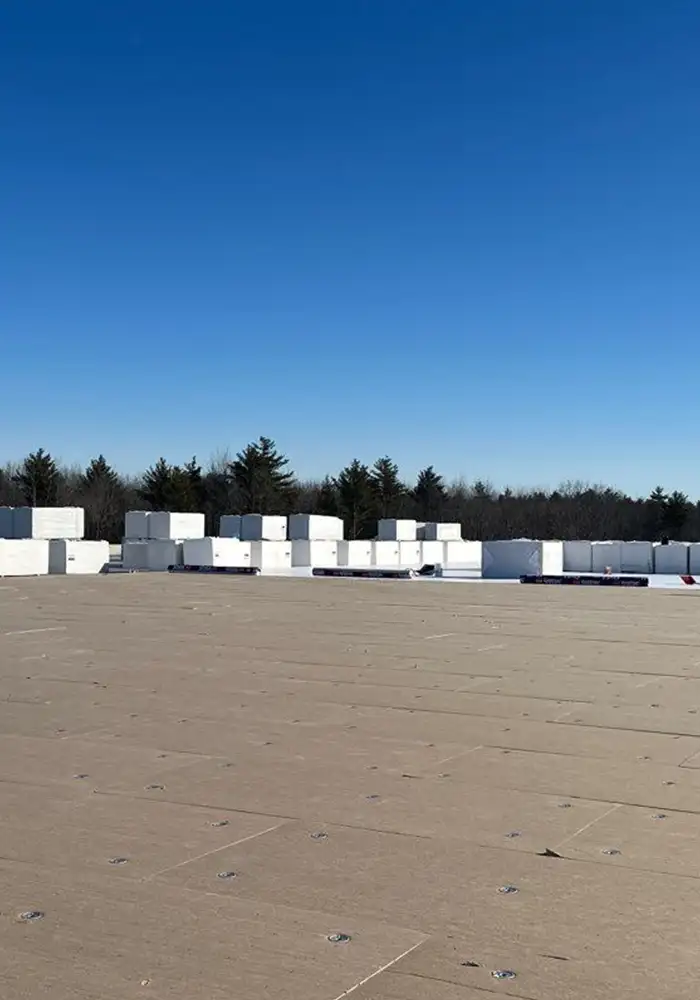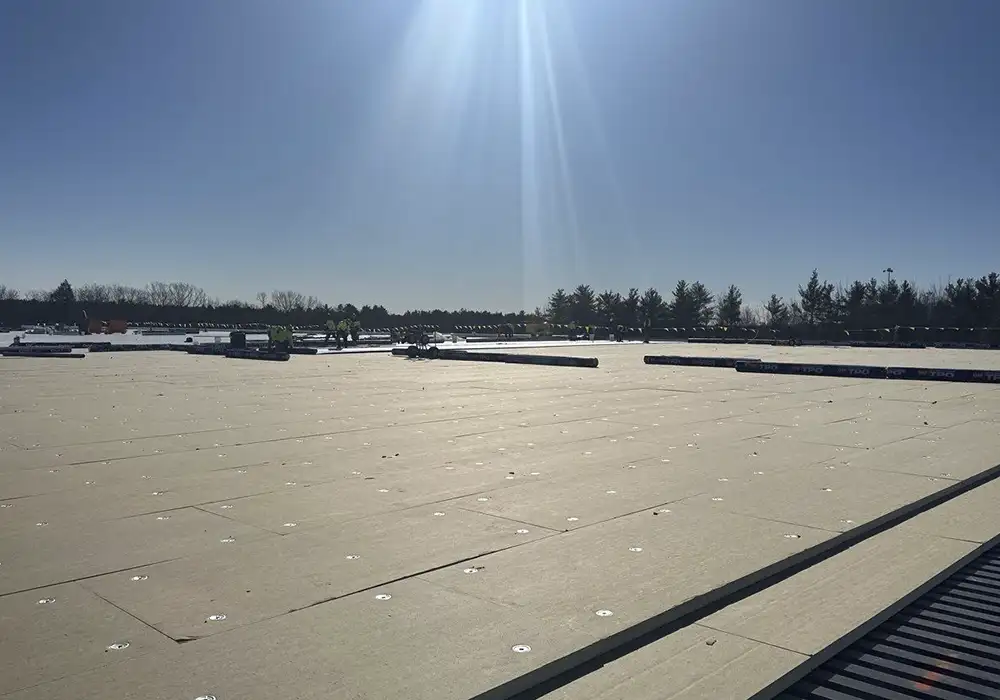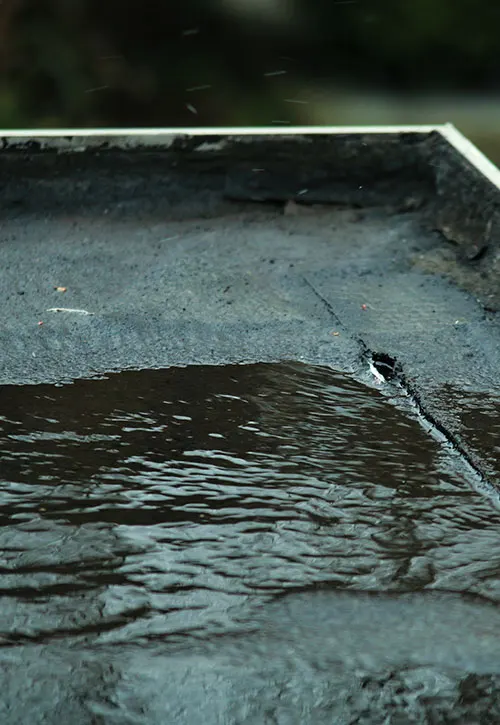Insulation


Roofing Insulation
There’s no question that choosing the right roofing membrane is important for protecting flat and low-slope roofs, but it’s also crucial to keep in mind that the roof system is just that – a system. It requires several layers of highly critical components in order to provide the proper amount of protection from wind, rain, and heating/cooling loss. These components include items such as waterproofing/vapor barriers, fasteners/adhesives, and, of course, insulation.
While there are several options available for commercial roofing insulation, they’re not all created equal. It’s crucial to make the best possible choice of insulation for your building type and climate, as it’s a key factor in how long the roof will last and how energy-efficient it will be.
What is the role of commercial roof insulation?
Commercial Roofing Insulation Materials
Though each of the following materials has its own set of merits and drawbacks, which we’ll discuss below, they’re easily some of the most widely used types of commercial roofing insulation:
Commercial Roof Insulation Performance

Commercial roof insulation is installed just under the roof’s membrane using installation methods that work best with the roofing system. While roof insulation is available in a wide range of materials, we’re going to focus just on rigid board insulation. The expected performance of commercial roof insulation considers the following:
Thermal resistance (r-value): R-value is the measurement depicting a material’s resistance to the flow of heat. While each layer of a commercial roofing system contributes to the overall thermal performance of the roof, the insulating layer is by far the largest contributor to the system’s r-value.
Durability & impact resistance: Since the roof of your building bears the brunt of the weather factors of your area, it’s crucial that the components of the roof system are durable and well-designed to properly protect your investment as well as the safety of those in and around your building. While the roof’s membrane is the first line of defense against heat/cold, water & snow, wind and debris, the insulation must be durable enough to absorb what the membrane doesn’t.
Fire resistance: Your roof’s membrane is fire-resistant, but if the membrane is breached, it’s crucial that the insulation underneath is not susceptible to burning, since the decking below is likely made from wood (even if your decking is steel, your roof should still be fire-resistant according to ASTM standards). Insulation that is properly fire-resistant plays a great role in not only preventing fires but also preventing any serious fire damage to the building’s structure. In the U.S., all commercial roofs are fire-tested by a qualified roofing QA inspector according to ASTM Test Method E-108 and E-119 for both combustibility and burn-through.
Type of insulation material: As mentioned above, there are 3 main types of rigid board insulation that we’ll compare here. They are polyisocyanurate (polyiso), extruded polystyrene (XPS), and expanded polystyrene (EPS).
- Polyiso:
Polyiso is closed-cell foam insulation with an r-value beginning at 8 and degrading to 5.5 over time. The blowing agents used to make polyiso have been tweaked throughout the decades to meet EPA compliance standards, and most no longer contain ozone-harming CFCs or HCFCsAs the most effective of the three insulation options discussed here, polyiso is the most commonly-used roof insulation board in North America and is both abundantly available and cost-effective. The polyiso industry has come up with its own set of standards for thermal resistance called Long Term Thermal Resistance (LTTR) that indicates not only the insulation’s initial r-value but also the aged r-value.Polyiso can be included as part of a LEED-certified green building, and it’s the only foam board that has been approved for direct application to steel roof decks. It is also the most specified foam cover board for its light weight and resiliency.
- XPS:
XPS is a blend of polystyrene polymers with an average r-value of 5. This specific type of foam board insulation can be recognized for its pink, green or blue for manufacturer brand recognition. While XPS isn’t commonly specified for most roof applications, it does rank middle of the road when it comes to r-value vs. cost. The drawback to XPS is that it is vulnerable to solvent-based adhesives as well as hot asphalt. While it’s a great choice for use with PMR (ballasted) roof systems, the added weight of this type of system is often a problem for the building’s structure. - EPS:
EPS is a polystyrene polymer injected with a foaming agent to make it expand. The average r-value ranges from 3.6 to 4.2. This material is easy to cut to size while on a jobsite, and it is incredibly lightweight, but it is combustible, susceptible to shrinkage and warping with high temperatures, and is incompatible with petroleum-based products. It’s also brittle and easily damaged by foot traffic.
Factors that can Compromise
Your Commercial Roof Insulation
Water
Regardless of how efficacious your roof’s insulation is, it has one universal weakness: water. Your insulation must be protected from intruding moisture, as it could become saturated and rendered ineffective. Wet insulation can also act as a conduit that allows water to travel across the roof and cause leaks elsewhere. You may see a leak, but the damage to the membrane might be several yards away, and all of your insulation in that span could now be ruined.
Workmanship
As the most common cause of commercial roof failure, improperly installed roofing is usually apparent shortly after the roof is completed. For this reason, most manufacturers require that their certified installers provide a two-year labor and materials warranty. Typically, if problems present themselves after the first two years, it’s not the fault of the installers.
Storms
Repair personnel


Failure to maintain
It’s important to have your roof inspected and maintained professionally in intervals that your roofer recommends in order to prevent problems before they happen, or catch a problem early enough for simple repairs to fix the issue. It’s also crucial, for the sake of your roof’s warranty, that you keep up on your recommended maintenance schedule, as failure to do so can void your warranty. A certified inspector will check for the following:
- Tears, punctures or holes
- Debris buildup
- Ponding water
- Deteriorated caulking
- Signs of damaged seams and/or flashing
- Integrity of roof curbs or other penetrations
Any of these signs of damage can indicate that water has made its way underneath the membrane and into the insulation, so it’s a good idea to always follow the manufacturer’s recommendations for its product, as well as to be sure to select components that work well together. Doing these things, as well as those recommended above, will help you keep your commercial roof in good condition for longer.
